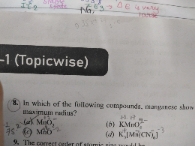JEE Class main Answered
Why should atoms have 8 electrons in their outer most valence shell, why can't they have 4 or 9 or any other number.Explain
Asked by ojili005 | 31 May, 2021, 19:20: PM
The usefulness of the octet rule is mostly for molecules which are made of nonmetal atoms. With the exception of hydrogen and helium, non metals are the p electron fillers on the right side of the periodic table. And further down the table the metals encroach on the left side of the p-fillers. Anyway, the p-filling atoms have valence electrons in the s and p sub levels. The s sub level can hold 2 electrons and the p sub level can hold 6 electrons. That's where the 8 electron stability comes from. Even when nonmetal atoms combine into molecules, there are enough orbitals for eight electrons. Bonding comes when electrons are shared between atoms so every atom has 8 electrons. The nuclei of neighboring atoms are attracted to the same electrons between them which is called bonding. When atoms make molecules, the s and p sub levels are usually significantly changed or “hybridized.” Nevertheless, there are still enough orbitals for 8 electrons around each atom.
There are about 5 exceptions to the octet rule. Here I cite two exceptions. Most notably is that hydrogen (and helium) has no valence p sub levels, so hydrogen (and helium) can only have 2 electrons. Since neutral helium has 2 electrons, no sharing is possible, so it makes no molecules. Neutral hydrogen has only one electron, and has ability to attract 2 electrons, so it bonds with other nonmetal atoms. Some of the bigger nonmetal atoms can hybridize using d sub levels and expand their octet to even more electrons. Of course, most of the nonmetal atoms attract 8 because they can accommodate valence s and p electrons.
The main quantum numbers for isolated atoms are n, l, m(l), and m(s). Each electron has its own unique set of these four quantum numbers for each atom. The values of n = 1,2,3,… corresponds to the period number on the periodic table for the nonmetallic atoms. For s electrons, l=0 forcing m(l)=0. So, there are 2 s electrons because the m(s)=+1/2,-1/2. For p electrons, l=1 allowing m(l)=1,0,-1. So, the p sub level has a possible 6 electrons because 3 m(l) values (1,0,-1) combines with 2 m(s) values (-1/2,+1/2).
There are about 5 exceptions to the octet rule. Here I cite two exceptions. Most notably is that hydrogen (and helium) has no valence p sub levels, so hydrogen (and helium) can only have 2 electrons. Since neutral helium has 2 electrons, no sharing is possible, so it makes no molecules. Neutral hydrogen has only one electron, and has ability to attract 2 electrons, so it bonds with other nonmetal atoms. Some of the bigger nonmetal atoms can hybridize using d sub levels and expand their octet to even more electrons. Of course, most of the nonmetal atoms attract 8 because they can accommodate valence s and p electrons.
The main quantum numbers for isolated atoms are n, l, m(l), and m(s). Each electron has its own unique set of these four quantum numbers for each atom. The values of n = 1,2,3,… corresponds to the period number on the periodic table for the nonmetallic atoms. For s electrons, l=0 forcing m(l)=0. So, there are 2 s electrons because the m(s)=+1/2,-1/2. For p electrons, l=1 allowing m(l)=1,0,-1. So, the p sub level has a possible 6 electrons because 3 m(l) values (1,0,-1) combines with 2 m(s) values (-1/2,+1/2).
Answered by Ravi | 01 Jun, 2021, 16:35: PM
JEE main - Chemistry
Asked by gattimadhavi434 | 25 Dec, 2023, 10:15: AM
JEE main - Chemistry
Asked by visalvinod85 | 23 Jun, 2022, 08:41: AM
JEE main - Chemistry
Asked by deba.biswas561 | 19 Jun, 2022, 09:00: AM
JEE main - Chemistry
Asked by rakeebalikcl | 13 Jun, 2022, 05:47: AM
JEE main - Chemistry
Asked by pachchigarkeyur | 25 Mar, 2022, 18:09: PM
JEE main - Chemistry
Asked by pachchigarkeyur | 22 Mar, 2022, 12:37: PM
JEE main - Chemistry
Asked by pachchigarkeyur | 22 Mar, 2022, 12:35: PM
JEE main - Chemistry
Asked by ojili005 | 31 May, 2021, 19:20: PM


